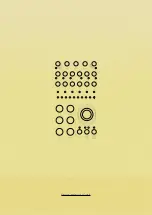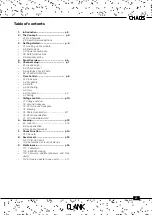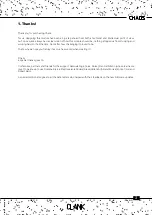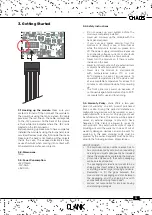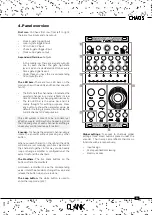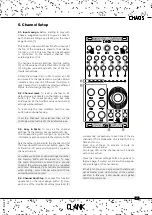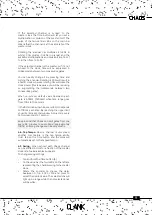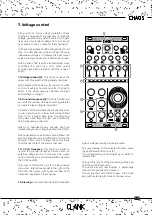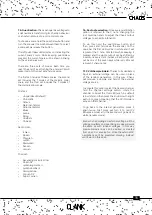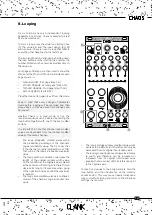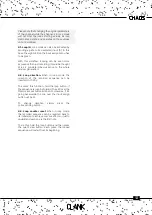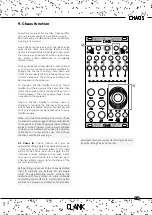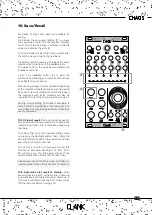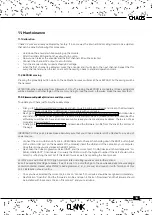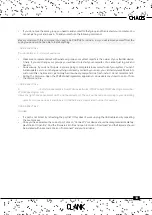
11
7.6. Root note selection.
Since every quantization
option is referred to the C note, changing the
root could be handy to adjust the
Chaos’
output
voltages to a specific intonation.
To do this hold the
quant/slew
button and
then press and hold down the encoder. On the
value bar the first LED will be in white and it will
represent the C note. Rotate CW while keeping it
pressed and the whole output will be shifted by
a semitone every dent increase. Each white LED
will be one of the seven keys while red LEDs will
represent sharp notes.
7.7. CV IN Sample & Hold.
Thanks to its dedicated
input an external voltage can be used in place
of the random generators. In this way, Chaos
will produce, a sample and hold of the external
voltage source.
To activate this option, select the desired channel,
hold the Channel settings button, rotate the
encoder to select the third LED (wich, by default
is in white) and then press the knob. Now the light
will turn to green, meaning that the CV IN mode is
active on that channel.
To go back to the internal generators, press it
again twice. First press will turn it to red (CV
transpose mode) and the second will go back to
white (random mode).
Even when sampling an external voltage, all the
voltage modifiers and quantizing modes will work
the same as with random voltages. In this way
precise melodic lines can be edited or created
from an LFO or envelop too. Since the external CV
oscillations can’t be predicted, Slewing, instead,
won’t work in this case.
7.5. Quantization.
Chaos can quantize voltages to
a defined scale transforming its chaotic behaviour
or an external source to a more melodic one.
To choose a scale, hold the
quant/slew
button and
turn the encoder to scroll between them. To select
a scale simply release the button.
The left
quant/slew
LED will stay on indicating the
current scale’s color. While keeping
quant/slew
pressed, the current scale will be shown blinking
on the value bar as well.
There are three sets of modes. Each time you
reach the end of a set turning the encoder CW will
make it skip to the next set and vice versa.
The first set includes 10 basic scales, the second
set includes the 7 modes of the melodic major
scale, and the third set includes the 7 modes of
the melodic minor scale.
First set:
•
Unquantized (Default)
•
Chromatic
•
Octave
•
Major pentatonic
•
Minor pentatonic
•
Blues
•
Arabic
•
Pelog
•
Hirajōshi
•
Chinese
Second set:
•
Ionian
•
Dorian
•
Phrygian
•
Lydian
•
Mixolydian
•
Aeolian
•
Locrian
Third set:
•
Ascending melodic minor
•
Dorian b2
•
Lydian augmented
•
Lydian dominant
•
Mixolydian b6
•
Locrian #2
•
Super Locrian
Summary of Contents for CLANK
Page 1: ...Chaos manual v 1 1...

